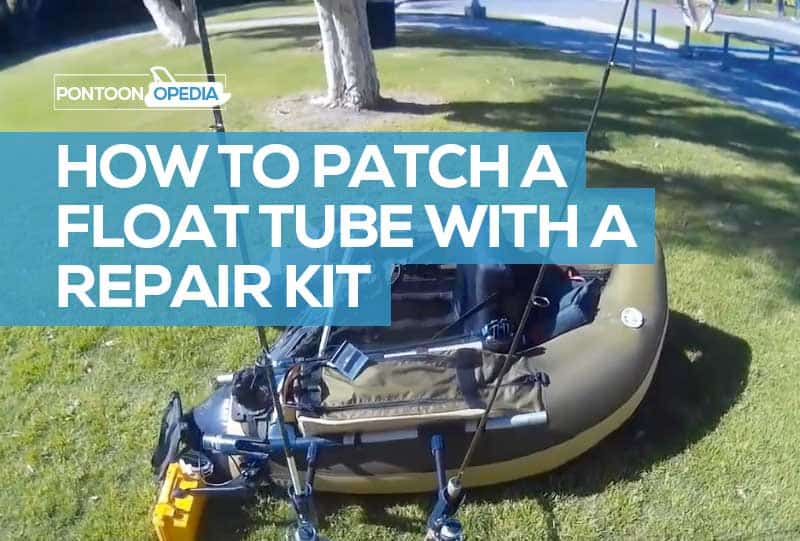Whilst most of the belly boats and float tubes currently on the market will be very hardy, with denier PVC underside, that doesn’t mean they can’t rip and tear from time to time. If you’re lucky, you will have a repair kit included when you bought your float tube.
If you no longer have a repair kit, I’ve got a recommendation below which I’ve always used – see that in step 1.
The thing with repairs and patches is that you have two approaches. You can use a special repair tape that will do a very quick job. That means you can get back into the water in super quick time, but don’t expect the repair to last too long.
The better alternative is to use a permanent repair adhesive. But with that, it will take a few hours to cure and stick. But it will be more long-lasting.
You need to make the decision; what repair and patch do you need to make right now?
I will outline both below.
How to patch a float tube or belly boat
In the short guide below, I will tell you the simple steps you need to take to patch a float tube quickly and easily.
1. Identify and find the leak
You might already know where the leak is, particularly if it’s a large tear caused by a rock, knife, or a seam starting to come apart. These will need more patching and aren’t really something you can repair on the go.
Small pinhole leaks are harder to find, but you can repair and patch them quickly, many times whilst actually out and about.
With larger holes, you might hear the air hissing as it escapes from the internal bladder and see some bubbling.
If you can’t easily find the tear or pinhole, you will need to push the tube bladder under water and watch for the tell-tale signs of air escaping. If you’re out on a lake, this is going to be dead simple to do.
If you’re at home, having access to a pool will really help, as you will need to push the float tube bladder under the water piece by piece – and this isn’t easy, so it helps if you have someone to give you a hand.
You’re going to get wet, but it’s worth it!
If you cannot get your float tube to a pool or tank that will fit it, lay the bladder out on the grass instead. Inflate it as much as you can, then with a bucket water, pour over the tube part by part and you should see the bubbles at some point.
Once you have found your pinhole or tear, use a waterproof wax crayon to mark it, or if you aren’t worried about marking the bladder permanently, something like a sharpie.
Handy Hint: When you find a pinhole to patch, don’t stop there. You could have more holes to repair, so never assume you’re done. Continue to check as you don’t want to go through this process again.
2. Make quick repairs with a patch
Now you have clearly marked where the repairs are needed, deflate the bladder, and let out as much of the air as you can.
The type of patch you need to do on your float tube will often depend on how old your tube is. The older models use large inner tubes.
If it’s a small tear in the PVC, a product like the Sea Eagle Repair Kit is a great stop gap solution, which you can quickly get going with. It cures very quickly.
However, if it’s a vinyl tear you need patching up, check out the Tear-Aid Vinyl repair kit instead. You can slap these patches on realty quickly, and get going again,
But, both of those solutions aren’t going to be the best for a long-term fix. Skip to step 3 to see what I recommend or longer-term patching on a float tube.
3. Longer-lasting repairs with Aquaseal
You might be lucky enough to already have some of this stuff as many float tube manufacturers include it in a repair kit when you buy your belly boat.
They trust it, and you should too.
It’s great for small pinhole repairs as you don’t need to use a patch. You can just squeeze it out onto the hole, and it will form a good enough bond.
For an extra layer or protection, you can also add a tear aid patch over the Aquaseal.
Aquaseal takes a day to fully bond but works amazing well so is best when you don’t have your float tube in the water for a longer-term repair job.
However, the pack I recommend below comes with a bottle of Cotol with it. Cotal acts as an accelerant and will reduce the curing time down from a day to just a few hours.
Check out the repair kit prices on Amazon.
The last word…
Float tubers should always carry a repair kit. It will let you patch your float tube in minutes.
However, the repair tapes you can buy can give a quick result but won’t be as hardy as a special patching liquid such as Aquaseal.
Aquaseal will take longer to work, but if you buy the pack which comes with the Cotol accelerant included, it will vastly reduce down the curing times.
Take the Tear Aid product with you in your kit bag and have the Aquaseal product at home. That gives you the best of both worlds.




